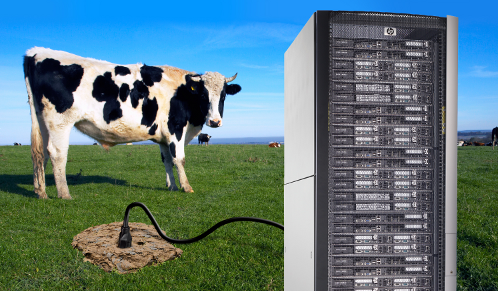
Fancy your internet business being powered by cow dung?
According to a recent research paper by HP, this is not a pipe dream. At the 4th ASME International Conference on Energy Sustainability in Phoenix, Arizona, which started May 17th this week, HP outlined how a farm of 10,000 cows could fufill the power requirements of a medium-sized 1-megawatt (MW) data center. The research was done by HP Lab’s sustainable IT ecosystem division, which seeks to design efficient green data centres using renewable energy resources.
Some fun facts according to HP:
- The average dairy cow produces about 55 kg (120 pounds) of manure per day, and approximately 20 metric tons per year – roughly equivalent to the weight of four adult elephants.
- The manure that one dairy cow produces in a day can generate 3.0 kilowatt-hours (kWh) of electrical energy, which is enough to power television usage in three U.S. households per day.
- A medium-sized dairy farm with 10,000 cows produces about 200,000 metric tons of manure per year. Approximately 70 percent of the energy in the methane generated via anaerobic digestion could be used for data center power and cooling, thus reducing the impact on natural resources.
- Using manure to generate power for data centers could provide financial benefit to farmers. HP researchers estimate that dairy farmers would break even in costs within the first two years of using a system like this and then earn roughly $2 million annually in revenue from selling waste-derived power to data center customers.
HP’s main business, of course, is not in the market of biofuel and green energy research. This market is crowded with players from the likes of mega-corporations like General Electric (GE) to cutting-edge start-ups like BloomEnergy.
HP’s research is into how a data centre could be powered using only sustainable biofuel, solar and wind resources off-the-grid. It is about managing all the different energy resources, each which varies depending on season and weather, to deliver the consistent power necessary to run a datacenter.
According to Chandrakant Patel, director of the sustainable IT ecosystem lab at HP Labs, widespread use of such technology could be a “growth economy” for countries like India. Good sun hours, a sizeable agricultural sector and a big demand for power are key reasons why this makes sense.
However, this technology still needs to undergo a detailed cost benefit analysis and feasability test in a real farm deployment which HP has yet to undergo, if I read the slides that they sent me right. Applying the research in a real world setting is where the real magic is, though it is great that IT companies like HP are looking into things like this. And of course they are not the only one, as the green IT movement is such a hot and trendy meme with IT marketeers nowadays.
In my opinion, green IT is a huge buzzword that, beneath its hippie veneer, is based more on the hard pragmatics of saving money than saving the environment. As oil keeps getting scarcer and goes up in price, multinational corporations look for alternative energy sources to wean us from our addiction to oil.
Might sound harsh and cold, but I actually think it’s good: Realist pragmatism is probably one of the best ways to effect change to conserve our planet.





Great idea. Now only if they can find a way to reduce gas emissions produced by cows.
<a href="http://externalharddrivedealsreview.com/="
Cow manure is not green because it comes from highly polluting enterprises. We need to switch to real renewable energy sources, such as solar and wind.
“Realist pragmatism is probably one of the best ways to effect change to conserve our planet.”
I agree. The majority of customers buy a product based on its price and performance, and not whether it’s sustainable or eco-friendly.
But if a green product can perform at least as well as a conventional one, AND costs less, then it will get adopted rapidly.